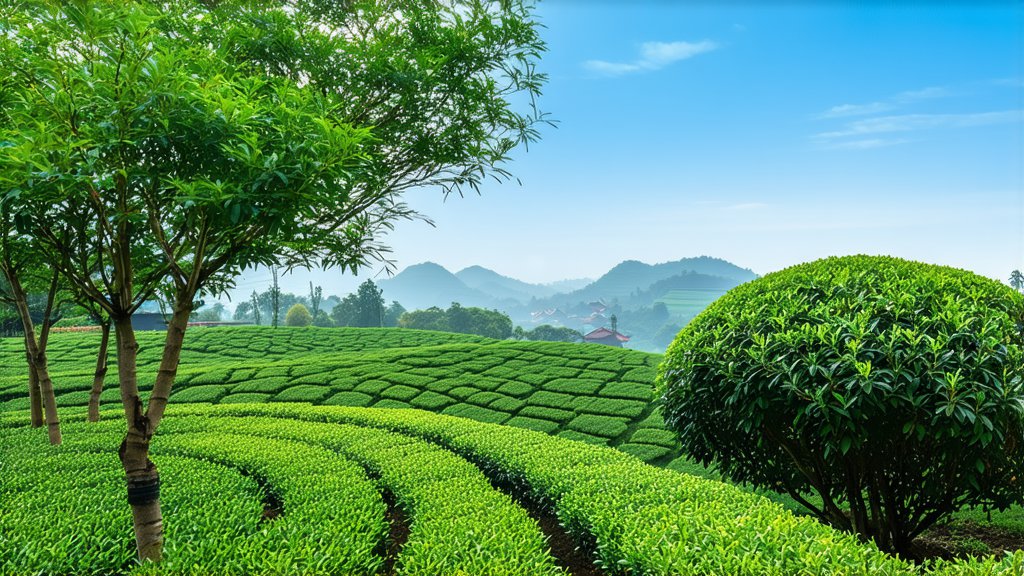
Tieguanyin, often referred to as the "Iron Goddess of Mercy," stands as one of the most revered varieties of Chinese oolong tea. Originating in the Anxi region of Fujian Province, this exquisite tea has garnered global recognition for its unique flavor profile and rich cultural heritage. As a distinguished expert in Chinese tea culture and a master of tea ceremonies, I am delighted to delve into the intricate history, diverse varieties, meticulous production process, and sophisticated art of appreciating Tieguanyin tea.
Historical Background
The story of Tieguanyin dates back to the early Qing Dynasty, around 1725 AD. According to legend, it was discovered by Wei Yin, a scholar who found a wild tea plant on the cliffs of Anxi's Mount Guanyin. Impressed by its exceptional quality, he propagated the plant and named it after his mother, whose maiden name was Wang. Over time, the tea gained widespread popularity and became synonymous with the region's tea-making traditions.
Varieties and Classifications
Tieguanyin encompasses several sub-varieties, each with distinct characteristics that cater to diverse palates. The primary classification is based on the degree of oxidation and roasting, which significantly influences the tea's aroma, taste, and appearance.
-
Qing Xiang (Green Flavor): This variety undergoes minimal oxidation and is known for its fresh, floral aroma and light, crisp taste. It embodies the essence of springtime, offering a refreshing experience akin to walking through a fragrant garden.
-
Hong Xiang (Red Flavor): With a slightly higher degree of oxidation, Hong Xiang exhibits a more robust character, featuring fruity and caramel notes reminiscent of roasted chestnuts or dried fruits. Its fuller body appeals to those seeking a deeper, more complex flavor profile.
-
Chen Xiang (Old Flavor): Aged or 'old' Tieguanyin undergoes extended storage, allowing its flavors to mature and evolve over time. These teas develop a unique earthiness, often accompanied by hints of wood, dried fruits, and even a subtle smokiness, making them a favorite among seasoned tea connoisseurs.
The Art of Crafting Tieguanyin
The creation of Tieguanyin is an intricate dance between nature and human skill, involving several meticulous steps:
-
Plucking: Only the youngest leaves and buds, typically the top two or three, are handpicked during the early morning when they are at their freshest and most vibrant.
-
Withering: The freshly picked leaves are spread out under the sun or placed in a withering room to reduce moisture content and soften the cell walls, preparing them for the next stages.
-
Shaking (Bao Sang): Leaves are gently tossed in bamboo baskets or shaken in specialized machines to further bruise the edges while preserving the central vein intact. This step encourages partial oxidation and releases the distinctive aroma.
-
Fixation: The leaves are then quickly pan-fried or steamed to halt oxidation, setting the foundation for Tieguanyin's unique flavor profile.
-
Rolling and Shaping: After fixation, the leaves are rolled to form tight pellets, enhancing extraction during brewing and contributing to the tea's visually appealing curled shape.
-
Roasting: Depending on the desired flavor profile, the rolled leaves may undergo multiple rounds of low-temperature roasting to develop their characteristic taste and aroma.
-
Sorting and Grading: Finally, the tea is sorted by size and quality, ensuring consistency and purity in every batch.
Appreciating Tieguanyin: The Tea Ceremony
To truly appreciate Tieguanyin, one must engage in the traditional Chinese tea ceremony, which elevates tea drinking from a simple act to an art form. Here are the essential steps:
-
Preparation: Begin by selecting high-quality loose leaf Tieguanyin and a suitable Yixing clay teapot or a Gaiwan (a lidded bowl). Warm the teapot with hot water to enhance the tea's aroma during brewing.
-
Measuring: Use approximately 5 grams of tea per 150ml of water. Adjust according to personal preference for stronger or milder flavors.
-
Rinsing: Briefly rinse the tea leaves with hot water (around 95-100°C) to awaken their flavors and remove any impurities. Discard this initial rinse.
-
Steeping: For the first infusion, steep the tea for about 15-30 seconds. Subsequent infusions can be progressively longer, as Tieguanyin can be steeped multiple times without losing flavor.
-
Aroma: Before taking the first sip, take a moment to appreciate the tea's fragrance. Lift the lid of the teapot or Gaiwan and inhale deeply, noting any floral, fruity, or roasted notes.
-
Tasting: Sip slowly, allowing the tea to coat your palate fully. Pay attention to the balance between sweetness, bitterness, astringency, and umami flavors. Notice how these elements evolve with each successive brew.
-
Observation: Examine the color and clarity of the liquor, which should range from light gold to deep amber depending on the variety and brewing time. Admire the unfurling leaves, revealing their vibrant green hue.
-
Reflection: Contemplate the overall experience, considering the harmony between aroma, taste, and visual appeal. Each session offers an opportunity for mindfulness and appreciation of nature's gifts.
In conclusion, Tieguanyin tea is more than just a beverage; it embodies centuries of tradition, craftsmanship, and cultural significance. From its storied origins in Anxi to its meticulous production process and the meditative practice of its tea ceremony, Tieguanyin invites us to slow down, savor the present moment, and connect with the rich tapestry of Chinese tea culture. Whether you are a seasoned tea enthusiast or a curious newcomer, Tieguanyin promises an unforgettable journey through the senses and into the heart of China's oolong legacy.